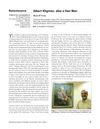
Search
forProducts matching "tretinoin cream"
Tracking 2 products like 671 A Ret-HC Cream 15 gm and 672 Melamet Cream 15gm from by companies like AllDayChemist. View all 2 products »
Sort by
Research
600-630 / 883 results
research Hair Casts
Tretinoin lotion can remove hair casts, which come from a specific part of the hair follicle and can be classified into two types.

research Albert Kligman, Also a Hair Man
Albert Kligman, known for his dermatology research and the discovery of tretinoin, was a significant figure in hair science but faced controversy for inmate experiments.
research Primary Localized Cutaneous Amyloidosis Presenting as Pigmented Papules Over Pinna
Pigmented papules on the ear can be a rare skin condition called cutaneous amyloidosis, treatable with topical tretinoin.
research Kerion Celsi Favored by the Use of a Tretinoin, Minoxidil, and Betamethasone Valerate Lotion in a 28-Year-Old Woman
A lotion with tretinoin, minoxidil, and betamethasone valerate helped treat a woman's skin infection.
research Help Offered
Using tretinoin and hydroquinone can speed up the fading of skin pigmentation.

research Reply
Dr. Jorizzo questions the long-term benefits of minoxidil and tretinoin, while Dr. Olsen defends their effectiveness and stresses the need for public education on these treatments.

research Hair Growth Therapies for Androgenetic Alopecia
Minoxidil, tretinoin, and finasteride may help hair regrowth in mild to moderate androgenetic alopecia.
research The Human Sebocyte Culture Model Provides New Insights Into Development and Management of Seborrhoea and Acne
The human sebocyte culture model has improved understanding of oily skin and acne, and how they can be treated.
research The Role of Retinoids in the Management of Cutaneous Conditions in Black Individuals
Retinoids help manage skin conditions in black individuals.

research Acneiform Dermatoses
Some skin conditions look like acne but are caused by drugs, and they usually get better when the drug is stopped.

research Telogen Alopecia Induced by UV Rays
UV rays can cause a type of hair loss known as telogen alopecia.

research Mites and the Mighty: The Last Work and Lasting Legacy of Albert M. Kligman, PhD, MD
Albert M. Kligman made major contributions to dermatology, including inventing a stain for fungi and advancing knowledge on skin diseases, and his legacy continues through his trainees and philanthropy.
research Hair Casts: A Clinical and Morphologic Study
A lotion helped remove hair casts, which seem to come from a specific part of the hair follicle, and patients with hair casts can be grouped based on the cause.
research Fox-Fordyce Disease: A Case Study of a 42-Year-Old Woman
The patient had a severe itchy rash and hair loss in the armpits.

research Albert M. Kligman: 90 Years Old on March 17, 2006
Albert M. Kligman, who turned 90 on March 17, 2006, made significant contributions to dermatology, including creating treatments for acne and studying skin aging.
research The Mexican Hairless Dog as a Model for Assessing the Comedolytic and Morphogenic Activity of Retinoids
Mexican hairless dogs can help test new skin treatments.

research Fzd2 Controls Multiple Aspects of Epidermal Development Through Distinct Signaling Mechanisms
Fzd2 is important for skin and hair development through various signaling ways.
research Improvement in Androgenetic Alopecia (Stage V) Using Topical Minoxidil in a Retinoid Vehicle and Oral Finasteride
The combination of topical minoxidil and oral finasteride improved hair regrowth in a man with advanced hair loss.

research Bald Scalps and Wrinkles: Concerns About Minoxidil and Tretinoin Treatments
The conclusion is that proper communication about the realistic effects of hair loss and skin aging treatments can improve dermatologists' credibility.

research Facial Hair Enhancement With Minoxidil—An Off-Label Use
Minoxidil can help increase facial hair growth.

research New Trends in the Treatment of Androgenetic Alopecia
Current treatments for androgenetic alopecia are limited, but research is ongoing to find better solutions.
research Alopecia Areata as a Sequela of Post-Reinfection COVID-19
COVID-19 reinfection may trigger alopecia areata.

research Spontaneous Intrinsic Aging in Organ-Cultured Human Skin as a Novel Ex Vivo Assay to Test Anti-Aging Actives
The document concludes that a new method has been developed to test anti-aging substances on human skin, showing that these substances can reduce skin aging signs.

research Multi-Dermatomal Unilateral Nevus Comedonicus Along the Lines of Blaschko: A Rare Presentation
A rare skin disorder, nevus comedonicus, can appear on one side of the body following Blaschko's lines.

research Acanthosis Nigricans During HAIR-AN Syndrome: The Tree That Hides the Forest
The case shows skin changes can indicate deeper health issues like insulin resistance, which are challenging to manage.

research Retinoid Induced Changes in the Fatty Acid Profile of Sebum and Its Effect on Bacterial Growth
Retinoids change the fat content in skin oil and reduce bacteria growth, helping to treat acne.

research Reply
Dr. Hanke acknowledges the success of CO₂ laser for less severe blast tattoos and suggests dermabrasion for more extensive injuries, while also discussing dermatology's media presence and issues with minoxidil research.
research Is Minoxidil Efficacious and Safe for the Treatment of Androgenetic Alopecia in Men, and If So, What Is the Optimal Strength and Means of Delivery?
5% minoxidil is safe and effective for treating male hair loss.

research Hair Growth Therapies for Androgenetic Alopecia
Using a mix of finasteride and minoxidil can significantly regrow hair in men with pattern baldness.